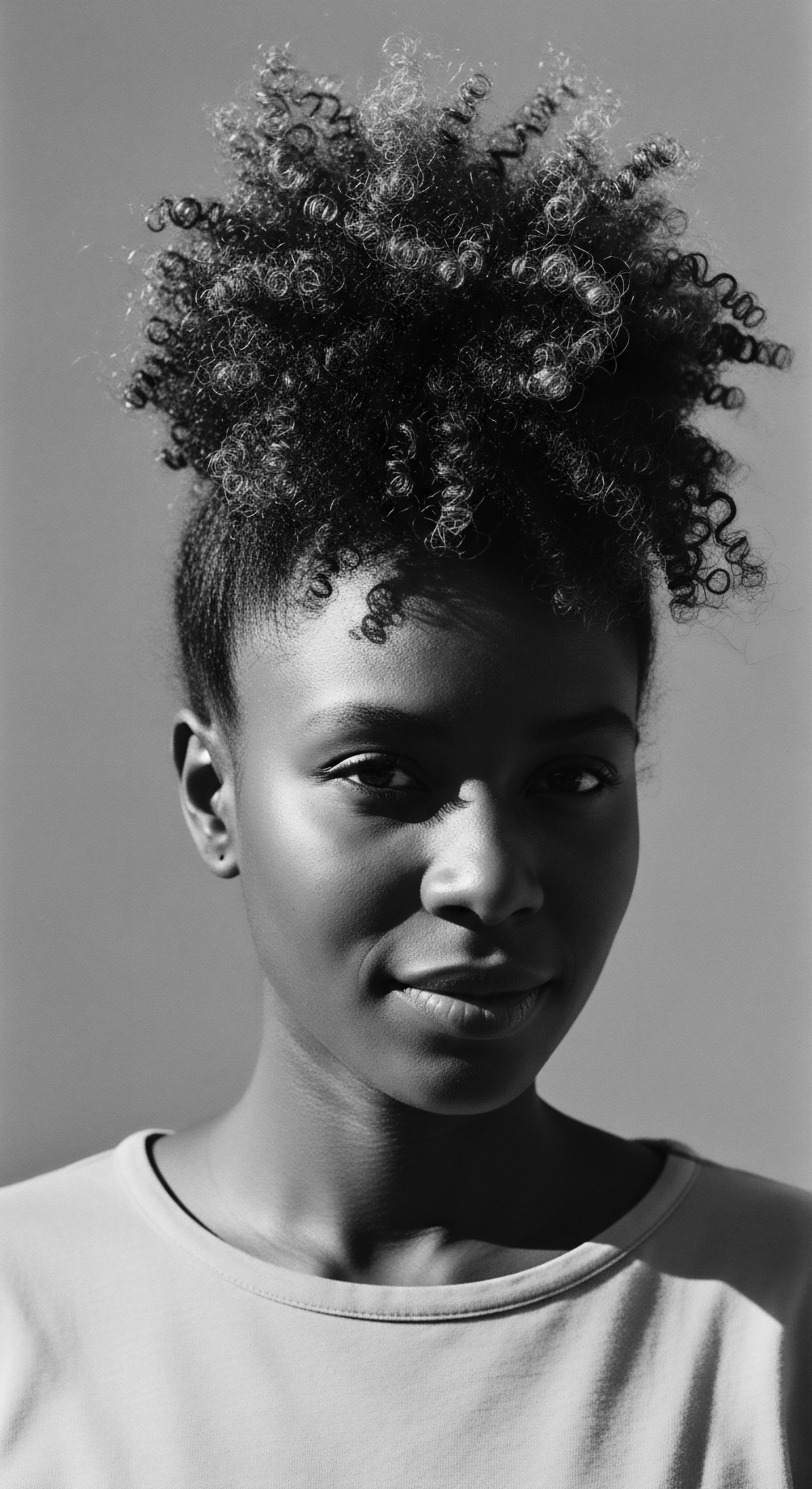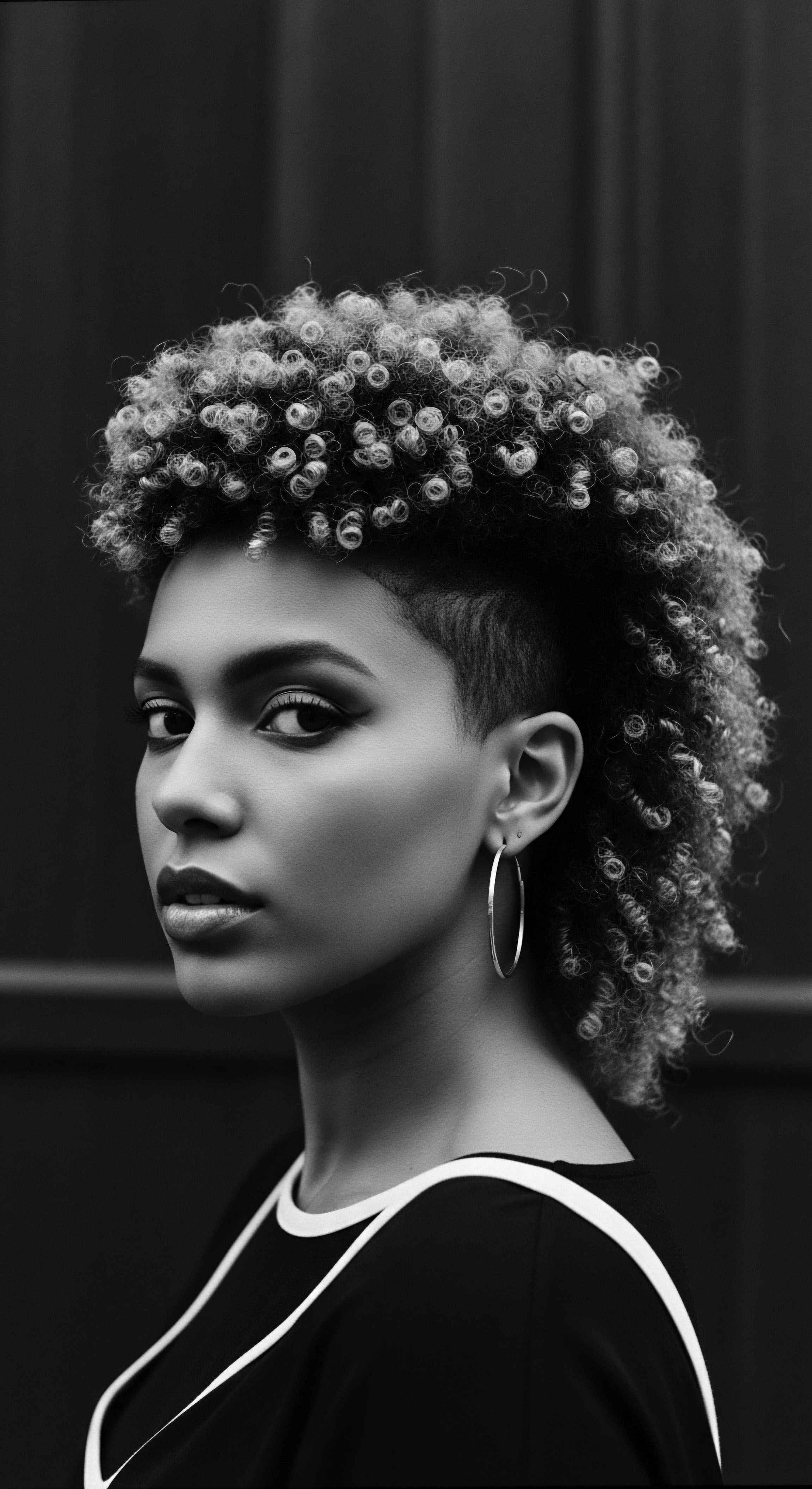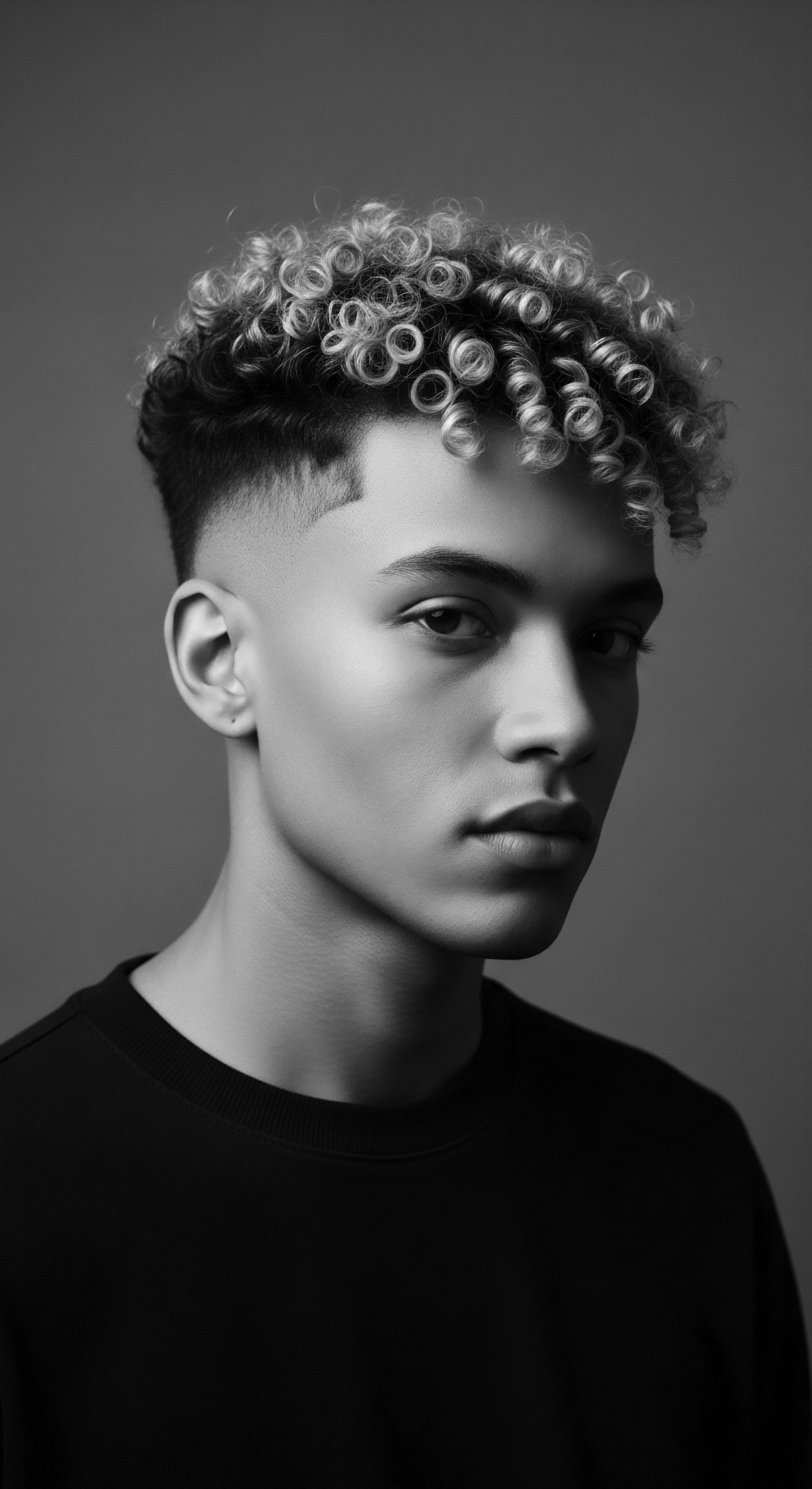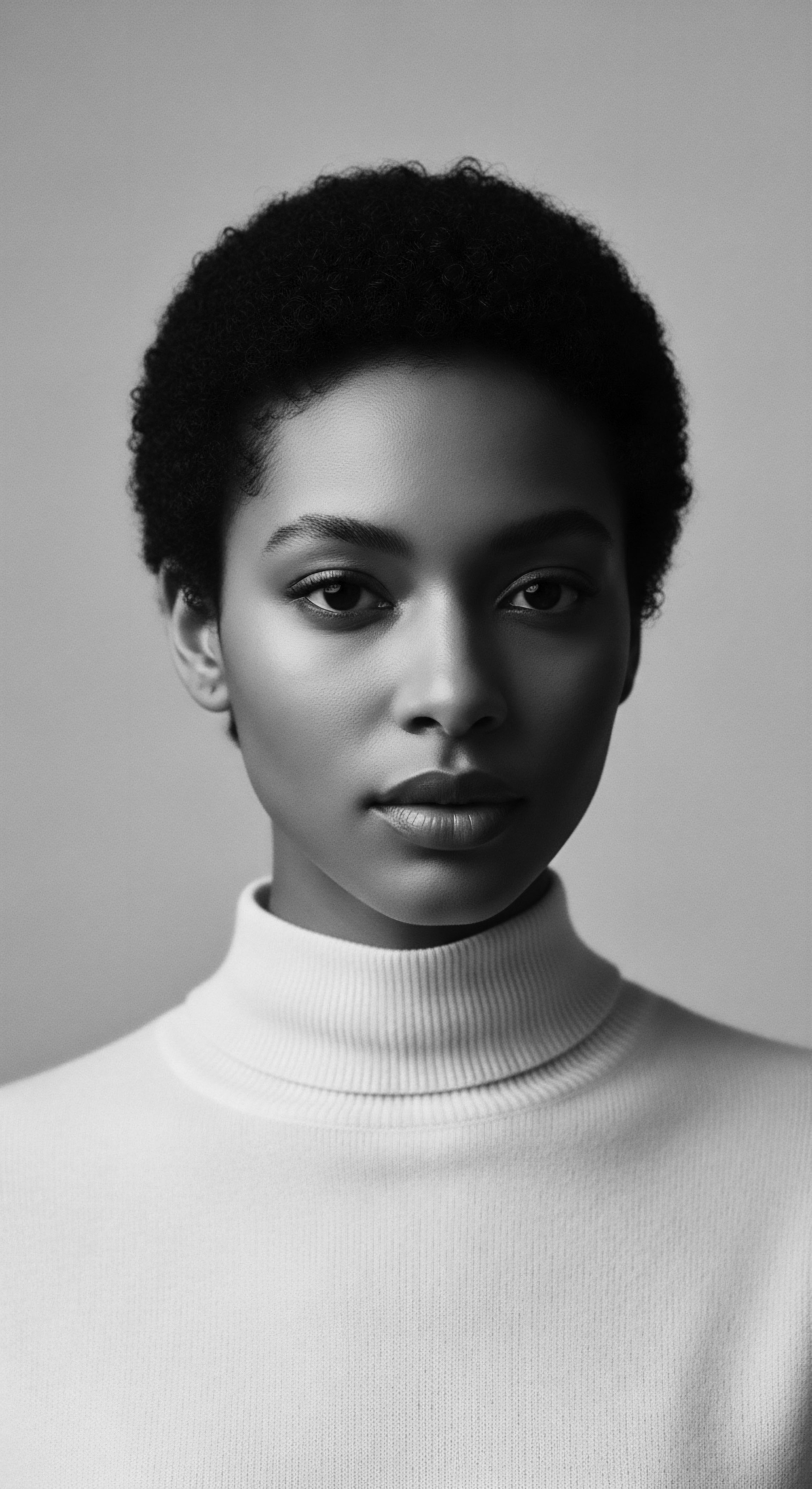
Fundamentals
In the vast, verdant expanse of textured hair care, the concept of “Textured Hair Water” stands as a foundational pillar, a quiet yet powerful force that has echoed through ancestral practices and continues to resonate in modern rituals. It is more than a simple liquid; it holds a specific Designation, a purposeful preparation of water intended to interact harmoniously with the unique architecture of coiled, curly, and wavy strands. This initial Explanation seeks to ground our understanding, presenting its most straightforward interpretation for those just beginning to explore the profound relationship between water and textured hair heritage.
At its simplest, Textured Hair Water signifies water that has been thoughtfully considered and often modified to enhance its interaction with the delicate and diverse formations of textured hair. This consideration might involve altering its mineral composition, infusing it with botanicals, or simply applying it with a heightened awareness of its hydrating capabilities. The ordinary becomes extraordinary when approached with intention, transforming a daily element into a cherished tool for hair vitality. The very presence of moisture, whether from the air or a direct application, breathes life into strands that thirst for hydration.
Textured Hair Water represents a deliberate application of water, often modified or infused, to nurture and hydrate the unique structure of coiled, curly, and wavy hair.

The Basic Hydration Principle
Understanding textured hair commences with recognizing its inherent need for moisture. The natural sebum, or scalp oil, struggles to travel down the intricate twists and turns of a coiled strand as effectively as it moves along a straight one. This structural reality makes textured hair inherently prone to dryness, a condition that compromises elasticity and leads to breakage.
Water, in its purest form, remains the most fundamental hydrator. When we speak of Textured Hair Water, we are, at a primary level, acknowledging this essential biological need.
The physical interaction of water molecules with the hair shaft is what allows strands to absorb and retain moisture. For textured hair, this absorption is vital for maintaining its structural integrity, flexibility, and natural curl pattern. Without adequate moisture, curls lose their characteristic bounce, feeling brittle and appearing dull. The thoughtful application of water becomes a conscious act of replenishment, a fundamental component of keeping coils soft, pliable, and vibrant.

Water as a Conduit of Care
Beyond mere hydration, Textured Hair Water often serves as a carrier for beneficial elements. Historically, this meant botanical infusions gathered from the land, chosen for their known properties to cleanse, soothe, or strengthen. In contemporary practices, it can refer to water that has been distilled to reduce mineral content or softened to mitigate the drying effects of hard water. This purposeful alteration transforms simple water into a more effective agent of care.
- Softened Water ❉ Water treated to lessen its mineral content, preventing buildup on hair and scalp. This helps cleansers work more effectively.
- Distilled Water ❉ Water purified through boiling and condensation, removing impurities and minerals entirely, ideal for sensitive scalps or product mixing.
- Rainwater ❉ Revered in some ancestral traditions for its natural purity and softness, collected and used for gentle cleansing.
- Infused Waters ❉ Water imbued with the properties of herbs, flowers, or fruits, adding natural conditioners or aromatic qualities.
The deliberate choice and preparation of water reflect a deeper appreciation for its role in the overall health of textured hair. This understanding dates back through generations, a silent agreement among communities that the quality of water profoundly impacts the vitality of hair. It is a simple yet profound gesture, linking elemental biology with a profound lineage of care.

Intermediate
Progressing our inquiry, the Meaning of Textured Hair Water deepens, extending beyond fundamental hydration to encompass a more intricate interplay of molecular science, environmental adaptation, and the subtle wisdom of ancestral practices. At this intermediate juncture, we begin to appreciate the nuanced ways water impacts the very fabric of textured strands and how communities throughout time have intuitively calibrated its use. The Interpretation here acknowledges the specific challenges and opportunities presented by hair’s unique structure.
Coiled and curly hair types possess a distinct elliptical cross-section, a shape that, when coupled with the natural twists and turns of the strand, creates a larger surface area relative to straight hair. This increased surface area, while contributing to the visual splendor of textured styles, paradoxically also means a greater susceptibility to moisture loss through evaporation. Textured Hair Water, in this context, is not just about saturating the hair but about introducing moisture in a manner that respects this architecture, allowing for deeper penetration and more sustained hydration. It is a carefully calibrated delivery system, recognizing hair’s porous nature.
Beyond basic hydration, Textured Hair Water addresses the unique porosity and structural needs of coiled hair, optimizing moisture absorption and retention in ways understood across generations.

The Science of Hydration and Porosity
Hair porosity, or the ability of hair to absorb and retain moisture, varies significantly among individuals, even within textured hair types. High porosity hair, often characterized by raised cuticles, absorbs water quickly but loses it just as rapidly. Low porosity hair, with tightly closed cuticles, resists initial water absorption but retains moisture once it permeates. Textured Hair Water, when understood in its broader context, often seeks to address these specific porosity needs.
For instance, warmer Textured Hair Water can gently lift low-porosity cuticles, allowing for better moisture penetration. Conversely, cooler water or a final rinse with such water helps to close cuticles on high-porosity hair, sealing in the introduced hydration. This subtle adjustment of temperature reflects an unwritten understanding of hair dynamics, a practical wisdom passed down, often without explicit scientific explanation, yet yielding beneficial results. The delicate molecular bonds within the hair are profoundly affected by water’s presence, influencing the hydrogen bonds that temporarily reshape curls.

Historical Water Sources and Their Influence
Ancestral communities, lacking modern laboratories, developed an acute observational understanding of the natural resources around them. The type of water available—whether soft rainwater, mineral-rich spring water, or harsher well water—shaped their hair care practices. The Delineation of Textured Hair Water through history often aligns with environmental conditions.
Consider the practices of the Himba People of Namibia, residing in one of Earth’s most extreme arid environments. Water scarcity is a lived reality for them. Due to this profound limitation, traditional hair care practices deviate significantly from water-based cleansing. Instead, Himba women apply an ‘Otjize Paste‘ – a unique mixture of animal fat, ground red pigmented stone, and aromatic resin from the omazumba shrub – to their hair and bodies, imparting a distinctive red glow and cleansing effect.
Hair washing with water is rare, a testament to the ingenuity of adapting care rituals to environmental constraints. This historical example powerfully illustrates how communities, faced with minimal access to conventional water sources, devised alternative yet equally effective methods to maintain hair health and cultural aesthetic. It underscores that “Textured Hair Water” does not always imply direct water application, but rather the intentional provision of liquid-based or moisture-retaining agents for cleansing and conditioning within a heritage context.

The Role of Infusions and Preparations
The preparation of water for hair care became an art form across various Black and mixed-race communities. The addition of herbs, grains, or even fermented elements transformed plain water into solutions with specific benefits. This practice, an intuitive form of herbal hydrotherapy, was rooted in centuries of ethnobotanical knowledge. The Specification of what constituted effective Textured Hair Water was often a communal understanding, honed by observation and shared wisdom.
For example, rice water, now widely recognized, holds ancient roots in East Asian traditions but has found adoption in various textured hair communities across the diaspora for its conditioning properties. Similarly, various herbal teas and decoctions were crafted, each plant contributing its unique properties.
These preparations were not random; they were a reflection of a holistic worldview where nature provided the answers, and careful preparation unlocked their potency. This continuous dialogue between available resources and the specific needs of textured hair forms the deep historical backdrop for our contemporary understanding of Textured Hair Water.

Academic
To approach “Textured Hair Water” from an academic vantage point demands a comprehensive Definition that transcends superficial applications, delving into its profound molecular interactions, historical anthropology, and socio-cultural Significance within Black and mixed-race hair experiences. This rigorous Explication positions Textured Hair Water not as a mere product, but as a dynamic concept, a confluence of scientific understanding and deeply rooted ancestral practice, capable of influencing the biophysical attributes of hair while simultaneously carrying immense cultural weight. Its Meaning is multi-layered, encompassing the chemical, the communal, and the symbolic.
At its most precise, Textured Hair Water refers to aqueous solutions, whether naturally occurring, modified, or specially formulated, whose chemical and physical properties are purposefully optimized to interact synergistically with the complex morphology of helically coiled, elliptically cross-sectioned hair fibers characteristic of many individuals of African and diasporic descent. This Elucidation acknowledges the distinct structural characteristics of textured hair, particularly its susceptibility to moisture deficit due to elevated surface-to-volume ratio and the tortuosity that impedes natural sebum distribution along the hair shaft. From a biophysical standpoint, the careful management of water’s interaction with the hair cuticle and cortex is central to maintaining elastic properties, mitigating hygral fatigue, and preserving conformational integrity. The nuanced control of parameters such as pH, mineral content, and interfacial tension within these aqueous preparations influences hydration efficacy, cuticle smoothing, and overall hair health.
Textured Hair Water, academically defined, is an optimized aqueous solution interacting precisely with textured hair’s morphology, preserving its structural integrity and cultural legacy.

Molecular Interplay and Hair Structure
The interaction of water with textured hair is a dance of molecular forces. Textured hair, with its unique internal and external structure, reacts distinctively to water. The hydrogen bonds within the hair’s keratin structure are sensitive to moisture, causing strands to swell and temporarily relax when wet, only to recoil as they dry. This phenomenon, often referred to as hygral fatigue, poses a challenge, as repeated cycles of extreme swelling and drying can compromise the hair’s cuticle, leading to increased porosity and damage over time.
Therefore, an academic understanding of Textured Hair Water involves selecting solutions that minimize excessive swelling while maximizing hydration retention. This might entail adjusting the water’s pH to be slightly acidic, helping to keep the cuticle scales flat and smooth, or incorporating humectants that draw moisture from the environment and bind it to the hair shaft, preventing rapid evaporation. The careful balancing of these elements, often instinctively practiced in ancestral traditions, now finds validation in advanced trichological research.

Socio-Historical Context and Ancestral Ingenuity
The historical trajectory of Textured Hair Water within Black and mixed-race communities offers a compelling narrative of resilience, adaptation, and profound indigenous knowledge. Access to clean water, or indeed any water, was not a given, particularly during the brutal era of the transatlantic slave trade and subsequent periods of systemic oppression. Enslaved Africans, stripped of their cultural instruments of hair maintenance and often denied even basic clean water, were forced to innovate, relying on what was available.
Historical accounts reveal improvisation with makeshift tools and the use of greases or butters for lubrication, a stark contrast to hair cleansing. Yet, even within these extreme constraints, the ingenuity persisted.
Research into traditional African American herbalism indicates that Water Infusions were a primary method for preparing remedies for both internal consumption and external washes within enslaved communities due to their accessibility. This practice of infusing water with herbs for medicinal or beautifying purposes was a clandestine yet vital preservation of ancestral botanical wisdom. The use of rainwater, collected for its inherent softness and perceived purity, was another deeply ingrained practice, reflecting an intimate connection with the natural world and a recognition of its benefits for delicate hair.
This deep-seated reliance on natural water sources, carefully selected and often infused, reveals an ancestral understanding of water’s profound properties, long before modern chemical analyses confirmed their efficacy. The deliberate preparation of water for hair cleansing and conditioning represents a continuous thread of care, adapting through epochs of profound challenge and cultural preservation.
For instance, documented practices among some West African communities prior to forced migration show an intricate system of utilizing specific natural water sources for ritualistic and cosmetic hair treatments. The anthropologist Zora Neale Hurston’s Ethnographic Work, particularly her collection of folklore and cultural practices from the African diaspora, obliquely references the reverence for natural springs and collected rainwater in various contexts, implicitly including their use for personal grooming and spiritual cleansing. While Hurston did not explicitly publish a ‘study’ on ‘Textured Hair Water,’ her meticulous documentation of the cultural life of Black communities in the American South and Caribbean reveals a consistent theme ❉ the sacred relationship with natural elements, water included, often extended to self-care rituals.
These unwritten traditions, passed down orally and through lived example, underscored water’s dual role as both a cleanser and a conduit for spiritual connection and physical well-being. This demonstrates a deep Purport in water’s role, far exceeding simple hygiene.

The Evolution of Aqueous Preparations
The contemporary concept of Textured Hair Water is an evolution of these ancestral foundations, now informed by advanced scientific understanding. Modern formulations leverage precise botanical extracts, hydrators, and pH adjusters to create aqueous mists, rinses, and refreshers that address specific hair needs without stripping natural oils.
| Aspect Water Source |
| Ancestral Practice (Historical) Collected rainwater, natural spring water, river water; often scarce or difficult to access. |
| Contemporary Application (Modern) Softened tap water, distilled water, deionized water for consistency and purity. |
| Aspect Additives |
| Ancestral Practice (Historical) Herbal infusions (e.g. rosemary, hibiscus), fermented rice water, plant barks, roots, animal fats (in water-scarce regions). |
| Contemporary Application (Modern) Specific botanical extracts, humectants (e.g. glycerin), hydrosols, pH adjusters, protein hydrolysates. |
| Aspect Preparation Method |
| Ancestral Practice (Historical) Steeping, boiling, or soaking plant materials in water; intuitive mixing based on observation. |
| Contemporary Application (Modern) Controlled formulations with precise ingredient ratios and pH balancing for stability and efficacy. |
| Aspect Primary Purpose |
| Ancestral Practice (Historical) Cleansing, conditioning, spiritual purification, strengthening, scalp health, traditional styling. |
| Contemporary Application (Modern) Hydration, curl definition, refreshment, detangling, nutrient delivery, reducing frizz, scalp balancing. |
| Aspect Cultural Significance |
| Ancestral Practice (Historical) Intertwined with survival, communal bonding, spiritual rituals, identity markers, acts of resistance. |
| Contemporary Application (Modern) Personalized wellness, self-expression, reconnection to heritage, consumer choice. |
| Aspect The ongoing dialogue between ancient wisdom and modern innovation continually refines the role of water in textured hair care, honoring its enduring connection to heritage. |
The academic purview also considers the psychological and sociological dimensions of Textured Hair Water. The act of caring for textured hair, often facilitated by thoughtful water practices, serves as a mechanism for reclaiming identity and challenging Eurocentric beauty standards that historically devalued Black and mixed hair. The accessibility of water, its quality, and its application methods are deeply intertwined with economic and social disparities, an important lens through which to view the term’s full Implication.
Communities facing water insecurity, as documented by reports indicating race as a strong indicator of water and sanitation access, experience profound impacts on identity and well-being. Thus, the very act of formulating and utilizing Textured Hair Water becomes a conscious step towards equity in hair care, a reclaiming of agency over one’s body and heritage.
The historical context of water’s scarcity and the innovation born from that constraint provides a significant backdrop to the contemporary understanding of Textured Hair Water. During the era of slavery, for instance, access to clean bathing water for personal hygiene, let alone hair care, was severely limited, forcing enslaved individuals to develop alternative methods of cleansing and conditioning. This historical reality underscores the Denotation of resilience embedded within the practice.
The modern iterations of Textured Hair Water are built upon this legacy, offering enhanced precision and scientific validation to practices that were once intuitive survival mechanisms. For instance, the understanding of how water impacts the protein structure of hair, causing the characteristic swelling and unswelling, now informs the creation of products designed to minimize this ‘hygral fatigue’ and maintain the hair’s integrity. The objective is not to eradicate this natural response but to manage it with a deeper understanding, thereby prolonging the health and vibrancy of textured strands.
This comprehensive view reveals that Textured Hair Water is more than a formula; it is a living concept, continuously shaped by biological realities, environmental pressures, historical narratives, and cultural aspirations. Its careful preparation and thoughtful application bridge ancient wisdom with modern scientific rigor, allowing for a profound appreciation of textured hair in all its inherent splendor. The continuing Exploration of its properties and applications opens new avenues for hair health and self-expression.

Reflection on the Heritage of Textured Hair Water
As we draw our inquiry to a close, a quiet understanding emerges ❉ Textured Hair Water, in its myriad forms and applications, is far more than a transient trend or a chemical formulation. It is a profound meditation on heritage, a whisper carried on the winds of time from ancestral hearths to our contemporary rituals. The story of water, interwoven with the coiled and magnificent strands of Black and mixed-race hair, is a narrative of resilience, innovation, and an abiding connection to the rhythms of the earth.
The very idea of a specific “Textured Hair Water” is a testament to the intuitive wisdom of those who came before us, who, without microscopes or chemical analyses, understood the nuanced needs of their hair. They recognized the softening touch of rainwater, the soothing qualities of steeped botanicals, and the cleansing power of deliberate application. These practices, born from necessity and a deep observational bond with nature, became sacred rituals, preserving both hair and identity through generations.
The journey of Textured Hair Water mirrors the journeys of our ancestors ❉ adapting, creating, and finding solace and strength in the face of adversity. From the Himba people’s ingenious use of otjize in water-scarce lands to the hidden herbal infusions of enslaved communities, the ingenuity displayed by those caring for textured hair in challenging circumstances serves as a powerful testament to human spirit and determination. These historical markers illuminate the enduring thread of self-care as a defiant act of self-preservation and cultural continuity.
Today, our growing scientific comprehension affirms much of what was once only known through experience and tradition. The molecular intricacies of water’s interaction with keratin, the impact of mineral content, the role of pH – these insights deepen our respect for ancestral methods. They are not merely quaint customs of the past; they are foundational wisdom, now illuminated by the lens of modern science.
The cultivation of Textured Hair Water, therefore, becomes a conscious act of remembrance. It is a daily acknowledgment of a rich and living heritage, an invitation to engage with our hair not as a challenge to be overcome, but as a sacred extension of self, deeply rooted in a lineage of beauty, strength, and ancestral knowledge. In every carefully chosen drop, in every intentional application, we honor the intricate beauty of the unbound helix and the tender thread of care that connects us to our past, allowing our heritage to truly flourish.

References
- Bovin, M. (2001). Nomads of the Sahel ❉ The Wodaabe. IWGIA.
- Byrd, A. D. & Tharps, L. (2014). Hair Story ❉ Untangling the Roots of Black Hair in America. St. Martin’s Press.
- Davis-Sivasothy, A. (2011). The Science of Black Hair ❉ A Comprehensive Guide to Textured Hair Care. Sivasothy Media.
- Hurston, Z. N. (1938). Tell My Horse ❉ Voodoo and Life in Haiti and Jamaica. J.B. Lippincott Company.
- Penniman, L. (2020). Farming While Black ❉ Soul Fire Farm’s Practical Guide to Liberation on the Land. Chelsea Green Publishing.
- Roller, K. J. et al. (2019). Closing the Water Access Gap in the United States ❉ A National Call to Action. Dig Deep and U.S. Water Alliance.
